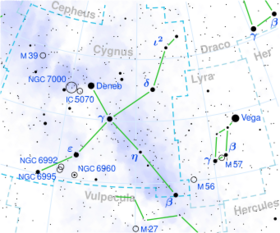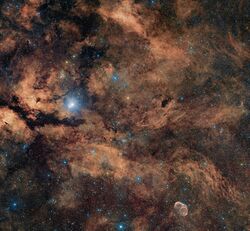Astronomy:HD 193322
| Observation data {{#ifeq:J2000.0|J2000.0 (ICRS)|Epoch J2000.0 Equinox J2000.0 (ICRS)| [[History:Epoch|Epoch J2000.0]] [[Astronomy:Equinox (celestial coordinates)|Equinox J2000.0}} | |
|---|---|
| Constellation | Cygnus |
| HD 193322A | |
| Right ascension | 20h 18m 06.9877s[1] |
| Declination | +40° 43′ 55.4947″[1] |
| Apparent magnitude (V) | +5.958[1] |
| HD 193322B | |
| Right ascension | 20h 18m 06.7684s[2] |
| Declination | +40° 43′ 54.3586″[2] |
| Apparent magnitude (V) | +8.23[2] |
| Characteristics | |
| HD 193322Aa | |
| Evolutionary stage | main-sequence star |
| Spectral type | O9Vnn[3] |
| HD 193322Ab1 | |
| Evolutionary stage | giant star |
| Spectral type | O8.5 III[3] |
| HD 193322Ab2 | |
| Evolutionary stage | main-sequence star |
| Spectral type | B2.5 V?[3] |
| HD 193322B | |
| Evolutionary stage | main-sequence star |
| Spectral type | B1.5 V[2] |
| HD 193322C | |
| Evolutionary stage | main-sequence star |
| Spectral type | B8 V[3] |
| HD 193322D | |
| Evolutionary stage | main-sequence star |
| Spectral type | B9 V[3] |
| Astrometry | |
| HD 193322A | |
| Proper motion (μ) | RA: -2.488[4] mas/yr Dec.: -6.837[4] mas/yr |
| Parallax (π) | 1.0669 ± 0.1403[4] mas |
| Distance | approx. 3,100 ly (approx. 900 pc) |
| HD 193322B | |
| Proper motion (μ) | RA: -3.070[5] mas/yr Dec.: -6.015[5] mas/yr |
| Parallax (π) | 0.9268 ± 0.0432[5] mas |
| Distance | 3,500 ± 200 ly (1,080 ± 50 pc) |
| Orbit[6] | |
| Primary | HD 193322Aa |
| Companion | HD 193322Ab |
| Period (P) | 44±1 yr |
| Semi-major axis (a) | 0.0525+0.0025−0.0020″ |
| Eccentricity (e) | 0.58+0.03−0.04 |
| Inclination (i) | 37+6−4° |
| Details[3] | |
| HD 193322A | |
| Mass | Aa: 21 M☉ Ab1: 23 M☉ Ab2: 9 M☉ |
| Surface gravity (log g) | Aa: 4.0 cgs Ab1: 3.5 cgs Ab2: 4.0 cgs |
| Temperature | Aa: 33,000 K Ab1: 32,500 K Ab2: 20,000 K |
| Rotational velocity (v sin i) | Aa: 350 km/s Ab1: 40 km/s Ab2: 200 km/s |
| Age | 7[7] Myr |
| HD 193322B | |
| Surface gravity (log g) | 4.0 cgs |
| Temperature | 23,000 K |
| Rotational velocity (v sin i) | 100 km/s |
| Other designations | |
| HD 193322A: TYC 3155-2321-1, Gaia EDR3 2062360626011542272 304.5291012654289 | |
| HD 193322B: TYC 3155-2321-2, Gaia EDR3 2062360626009209856 | |
| HD 193322C: UCAC2 46029301, 2MASS J20180562+4043248, Gaia EDR3 2062359152847218432 | |
| HD 193322D: UCAC2 46029306, 2MASS J20180691+4043055, Gaia EDR3 2062359084127740032 | |
| Database references | |
| SIMBAD | data |
| data2 | |
| data3 | |
| data4 | |
| data5 | |
HD 193322 (HR 7767) is a group of six stars which appear to be at least loosely bound into a system in the constellation Cygnus.[6] The stars comprise the core of the young open cluster Collinder 419 (Cr 419), which contains a total of 51 known stars.[8] Another prominent member of the cluster is the eclipsing binary star V470 Cygni (mk) (HD 228911). The cluster lies at a distance of about 3500 light years and its stars are only a few million years old.
System
HD 193322
|
| |||||||||||||||||||||||||||||||||||||||||||||
HD 193322A
The brightest and most massive component, HD 193322A, is a triple star system and emits 89% of the system's visible light. It is composed of Aa and Ab on an eccentric 44-year orbit. The binary Ab itself consists of stars Ab1 and Ab2 on a 311.03±0.25 d orbit.[9] The total mass of the system HD193233A has been calculated to be 76.1+9.9
−7.4 M☉,[6] although the individual stellar masses give a smaller total.[3]
HD 193222Aa has spectral class O9Vnn, indicating a main-sequence star with highly-broadened absorption lines due to rapid rotation. HD 193322Ab1 has spectral class O8.5III, although its derived physical properties suggest it may actually be on the main sequence. Its companion HD 193322Ab2 is a main-sequence star of spectral class B2.5. The Ab pair may have a combined mass and brightness greater than Aa.[3]
HD 193322B
HD 193322B is a single B-type main-sequence star separated from HD 193322A by 2.76 arcseconds on the sky, which puts them at least 2,780 astronomical units (AU) apart. Making several assumptions, the orbital period would be about 11 thousand years. HD 193322B produces 11% of the visible light emitted by the six-star system.[3]
Other components
The components HD 193322C and HD 193322D are late B-class main sequence stars, respectively 34″ and 50″ from the central star. It is unclear if the two are gravitationally bound to the system.[9] HD 193322D is a suspected Lambda Boötis star.[10]
References
- ↑ 1.0 1.1 1.2 "HD 193322A". SIMBAD. Centre de données astronomiques de Strasbourg. http://simbad.u-strasbg.fr/simbad/sim-basic?Ident=HD+193322A.
- ↑ 2.0 2.1 2.2 2.3 "HD 193322B". SIMBAD. Centre de données astronomiques de Strasbourg. http://simbad.u-strasbg.fr/simbad/sim-basic?Ident=HD+193322B.
- ↑ 3.0 3.1 3.2 3.3 3.4 3.5 3.6 3.7 3.8 Ten Brummelaar, Theo A.; O'Brien, David P.; Mason, Brian D.; Farrington, Christopher D.; Fullerton, Alexander W.; Gies, Douglas R.; Grundstrom, Erika D.; Harkopf, William I. et al. (2011), "An Interferometric and Spectroscopic Analysis of the Multiple Star System Hd 193322", The Astronomical Journal 142 (1): 21, doi:10.1088/0004-6256/142/1/21, Bibcode: 2011AJ....142...21T
- ↑ 4.0 4.1 4.2 Brown, A. G. A. (2021). "Gaia Early Data Release 3: Summary of the contents and survey properties". Astronomy & Astrophysics 649: A1. doi:10.1051/0004-6361/202039657. Bibcode: 2021A&A...649A...1G. Gaia EDR3 record for this source at VizieR.
- ↑ 5.0 5.1 5.2 Brown, A. G. A. (2021). "Gaia Early Data Release 3: Summary of the contents and survey properties". Astronomy & Astrophysics 649: A1. doi:10.1051/0004-6361/202039657. Bibcode: 2021A&A...649A...1G. Gaia EDR3 record for this source at VizieR.
- ↑ 6.0 6.1 6.2 Maíz Apellániz, J. (2019), "Gaia DR2 distances to Collinder 419 and NGC 2264 and new astrometric orbits for HD 193 322 Aa,Ab and 15 Mon Aa,Ab", Astronomy & Astrophysics 630: A119, doi:10.1051/0004-6361/201935885, Bibcode: 2019A&A...630A.119M
- ↑ Roberts, Lewis C.; Gies, Douglas R.; Parks, J. Robert; Grundstrom, Erika D.; McSwain, M. Virginia; Berger, David H.; Mason, Brian D.; Ten Brummelaar, Theo A. et al. (2010), "The Membership and Distance of the Open Cluster Collinder 419", The Astronomical Journal 140 (3): 744, doi:10.1088/0004-6256/140/3/744, Bibcode: 2010AJ....140..744R
- ↑ Cantat-Gaudin, T.; Jordi, C.; Vallenari, A.; Bragaglia, A.; Balaguer-Núñez, L.; Soubiran, C.; Bossini, D.; Moitinho, A. et al. (2018), "A Gaia DR2 view of the open cluster population in the Milky Way", Astronomy & Astrophysics 618: A93, doi:10.1051/0004-6361/201833476, Bibcode: 2018A&A...618A..93C
- ↑ 9.0 9.1 McKibben, W. P.; Bagnuolo, Jr, W. G.; Gies, D. R.; Hahula, M. E.; Hartkopf, W. I.; Roberts, Jr, L. C.; Bolton, C. T.; Fullerton, A. W. et al. (1998), "A Long-Period Spectroscopic Binary in the O-Star Multiple System HD 193322", Publications of the Astronomical Society of the Pacific 110 (750): 900–905, doi:10.1086/316211, Bibcode: 1998PASP..110..900M
- ↑ Renson, P.; Faraggiana, R.; Boehm, C. (1990), "Catalogue of Lambda Bootis Candidates", Bulletin d'Information du Centre de Donnees Stellaires 38: 137, Bibcode: 1990BICDS..38..137R
 |



